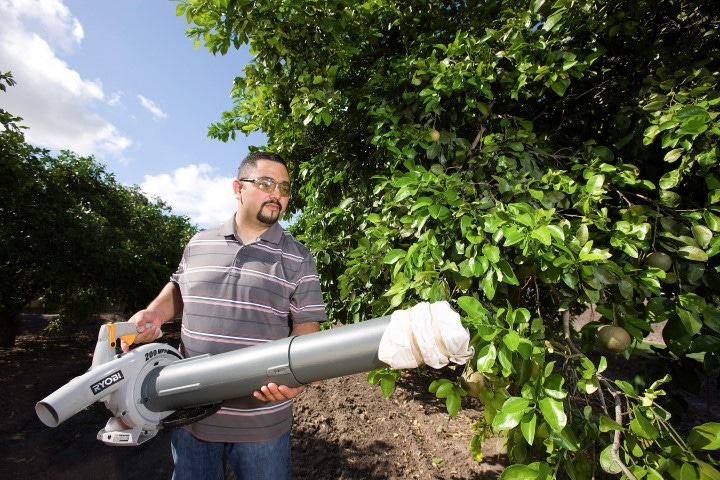
Citrus: State status update on ACP, HLB disease
Florida : Since the first HLB discovery a decade ago, more than 15,000 citrus jobs have been lost, mostly in fresh fruit packinghouses and processing plants.California: More and more samples from the Hacienda Heights (L.A. area ) are coming back with inconclusive HLB results.Arizona: The University of Arizona is the primary laboratory test site for HLB samples.
June 19, 2015

Citrus-producing states continue to circle the wagons to ward off the evil Asian citrus psyllid (ACP) and Huanglongbing (HLB) disease intruders. The following is a roundup (status report) of pest and disease information in Florida, California, Arizona, and Texas.
These assessments are from University of Arizona Tree Crop Specialist Glenn Wright based on his notes from the 4th International Conference on Huanglongbing he attended, along with information from Brian McGrew, the Arizona Department of Agriculture’s (ADA) quarantine program coordinator.
Florida
Florida was the first state where HLB (also called citrus greening) surfaced. Commercial citrus acreage in Florida has dropped a whopping 42 percent since 1996 – from 817,000 acres down to 515,000 acres with most lost from HLB. Other losses are tied to citrus canker disease, hurricanes, and urban development.
Wright shared that Florida has about 100,000 acres of abandoned groves where rains still nurture leaf development and further opportunities for psyllid population growth and spread.
Since the HLB discovery, more than 15,000 citrus jobs have been lost in Florida citrus, mostly in fresh fruit packinghouses and processing plants. Production has fallen 56 percent from 244 million 90-pound boxes to 103.7 million boxes. Some believe the drop could stop at 98 million boxes before it rebounds.
Even with the losses, the Florida citrus industry remains a $10 billion economic driver to the state.
More than $225 million has been spent or appropriated for ACP-HLB research, funded by growers and taxpayers.
While Florida growers need to plant 3.1 million trees per year, nursery supplies are in the 2.3 million tree range annually. All citrus plants are grown under screen.
Soft drink giant Coca Cola has committed several millions of dollars to citrus research since the company is a large orange juice supplier through its Minute Maid brand.
California
The psyllid continues to march northward in the Golden State. Usually, one to four psyllids are found at a find site. As of mid-February, 800 acres of commercial citrus were treated for the psyllid, says Wright.
Implementation continues for citrus health management areas, or CHMAs for short, where neighboring commercial growers work collectively in groves to prevent ACP and HLB issue. The release of the Tamarixia radiata predatory wasp, introduced by the University of California, Riverside, is widespread in residential areas for psyllid control.
The wasp lays an egg in the ACP nymph. The egg hatches and consumes the nymph and then exits from the psyllid’s exoskeleton to search for more nymphs.
More and more ACP samples with inconclusive HLB results are being found in the Hacienda Heights area, the site where the state’s only confirmed case of HLB was found in a Pummelo tree. The Riverside area is a hotspot for inconclusive samples.
Arizona
Brian McGrew of ADA says psyllid numbers continue to climb in the Grand Canyon State with 220 ACP find sites as of early May. Psyllid movement is to the north, starting from Yuma County into the Colorado River counties of La Paz and Mohave and westward into Pima, Pinal, Santa Cruz, and Maricopa counties.
About 250 total ACP detections have been made since the first detection in October 2009. ACP populations in Arizona are relatively low compared to other states. An ACP quarantine in the state stretches more than 22,000 square miles.
In a cooperative effort between the U.S. Department of Agriculture and ADA, Arizona launched a version of UC Riverside’s Tamarixia radiata biocontrol program with releases in Yuma County and Lake Havasu City (La Paz County).
Parasitism
McGrew said, “We have seen some signs of parasitism but we need more data to evaluate the efficacy of the Tamarixia program.”
ADA has tapped the University of Arizona (UA) as the primary laboratory test site for HLB samples. The UA tested about 1,200 citrus tissue samples for the disease last year. The numbers could surpass 2,000 this year.
All samples to date tested negative for the disease.
Texas
HLB was found in Texas in 2012. In January, Texas had 225 residential trees and 56 commercial trees which were positive for HLB.
For the latest on western agriculture, please check out Western Farm Press Daily and receive the latest news right to your inbox.
You May Also Like



